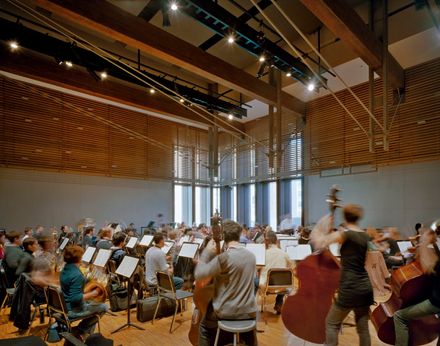
The Royal Conservatory, TELUS Centre For Performance And Learning
ARCHITECTS
Kpmb Architects
PHOTOGRAPHS
Eduard Hueber, Tom Arban
AREA
1900000.0 m2
YEAR
2009
LOCATION
Toronto, Canada
CATEGORY
Schools
Text description provided by architect.
The new TELUS Centre for Performance and Learning is the final phase in the Master Plan to build a new home for Canada’s premier music and arts educator, the Royal Conservatory.
KPMB, under the direction of Marianne McKenna, has been working with the RCM to realize the vision set forth in the 1991 award winning Master Plan.
ACADEMIC CULTURAL HYBRID
The overall project involved the progressive restoration of McMaster Hall and the construction of a new TELUS Centre for Performance and Learning to create a unique hybrid of a teaching and rehearsal facility and destination concert venue with three major performance venues.
The space between the historic and new building is enclosed to create a skylit pedestrian court linking the Bloor Street entrance to the Concert Hall and Lobby.
The glass and steel structure of the new addition provides a dynamic counterpoint to the polychromatic facades of the heritage buildings.
Urbanistically, the project occupies an important site in mid-town Toronto at the threshold of the University of Toronto’s downtown campus and integrates Philosopher’s Walk, a landscape pedestrian route that runs north and south linking Bloor Street to Hoskin Avenue.
The design was strategically conceived to define a new cultural precinct for the City in concert with the transformation of the adjacent ROM and the expansion of the Gardiner Museum around the corner on Queen’s Park.
Although the new additions are substantive in scale and size, the siting, massing and articulation is deferential to the 19th century heritage buildings on Bloor Street which have housed the RCM since 1962.
The emphasis on transparency and contemporary building systems create a dynamic counterpoint to the polychromatic masonry walls when encountered from Philosopher’s Walk.
KPMB was also involved in the restoration of the exterior heritage fabric and 240-seat Ettore Mazzoleni Hall.A key mandate was to maximize the capacity and flexibility for integrating new technology and adapting to changes and growth in programs.
The new additions include 43 new teaching and practice studios, the renovation of Ihnatowycz Hall (1898) and a new 150-seat Conservatory Theatre, a rehearsal space designed to accommodate a range of functions, from special events to the Learning Through the Arts.
In scale and proportion it replicates the acoustic quality and stage size of the main Koerner Concert Hall to prepare students for live performance.






















